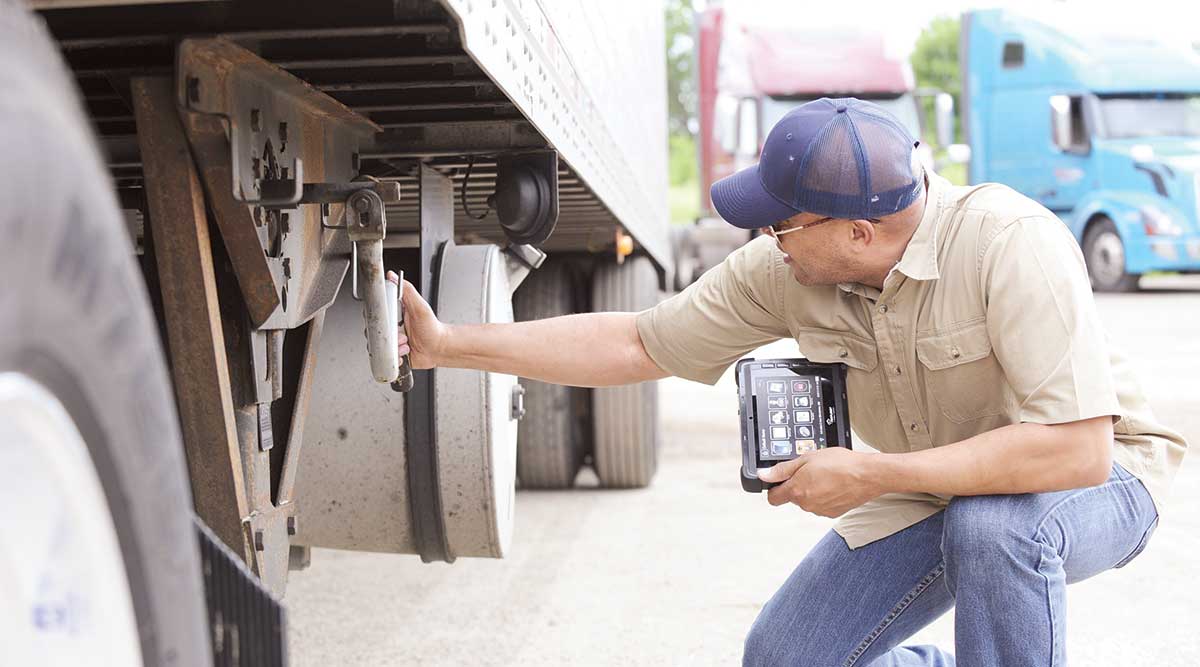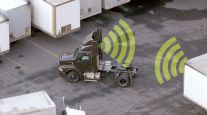Telematics Providers Going Mobile to Expand Capabilities Outside of Cab

This story appears in the May 29 print edition of Transport Topics.
The mobile device revolution, started by the release of the first Apple iPhone 10 years ago this summer, has transformed the way fleets communicate with their drivers. For many years, fleet telematics relied solely on proprietary, fixed-mount units in the cab to serve as driver interfaces, but today many telematics vendors offer fleets the ability to communicate with their drivers through mobile devices, ranging from personal smartphones to proprietary tablets that can be easily removed from the cab.
Extending telematics connectivity beyond the confines of the cab has distinct advantages. With telematics- empowered mobile devices, drivers can exchange messages with the home office while away from the truck, conduct vehicle inspections, edit or certify hours-of-service logs, transmit proof of delivery, capture signatures and more.
At the same time, the use of mobile devices forces fleets to answer some tough questions about the risks that come with the technology.
If a mobile device is used for compliance with the upcoming electronic logging device mandate, what happens if that device is lost or broken?
Is company data secure on a personal mobile device that the driver carries everywhere?
As technology advances, is it wiser to stick with a trusted proprietary platform or move to an open platform?
“The Teletrac Navman system can operate on any Android device but, in most cases, we provide the tablet,” said Sid Nair, senior director of transport and compliance for Teletrac Navman. “Most of our customers want their drivers to use a device that is dedicated only to trucking operations, predominantly because they want to ensure that the device is always with the truck.”
Having the device stay with the truck takes on added significance when HOS issues are involved.
“How many times have you forgotten your smartphone and left it somewhere?” Nair asked. “Today you can manage with paper logs, but later this year when the ELD mandate begins, if you don’t have the device that logs your hours, you can’t drive legally. You’re risking audits and fines.”
Pete Allen, executive vice president of sales for MiX Telematics North America, called the use of mobile devices “a double-edged sword.” The MiX system comes with an Android tablet that is permanently installed in the cab.
“Having a device that stays in the cab protects the driver,” Allen said. In contrast, with mobile devices, “if you’re in and out of vehicles frequently, there’s a good chance you’ll drop, lose or break your device, and if that happens, you’re in trouble from an HOS perspective.”
MiX supplements the in-cab unit with MiX Go, a mobile device app that allows drivers to create forms electronically, capture signatures, take photos and scan documents with a smartphone.
“Most fleets have specific business or operations reasons to choose between a locked-down device and a mobile device,” said Ravi Kodavarti, director of product management at Rand McNally. “Some fleets prefer to have a locked-down device in the cab. They know it’s there and they don’t have to worry about it. Other fleets want to give their drivers the flexibility to use the system away from the cab.”
Rand McNally offers two options for the driver interface. “You can use the Rand McNally tablet or your own iOS or Android mobile device,” Kodavarti said. “The app and the in-cab solution have the same functionality, and you have the option of using both.”
Omnitracs straddles the divide between proprietary and open systems by offering multiple solutions. Fleets can choose to use their own devices and use an Omnitracs mobile app for Android or Windows or they can opt to interface with the telematics system through a “feature-rich onboard computer” provided by Omnitracs, said Laura Lohrke, senior product manager at Omnitracs. For fleets that choose the onboard computer option, drivers can use Android or iOS devices to run a “helper application” for out-of-the-cab functions.
PeopleNet users also have a variety of options, including a proprietary device that is permanently mounted in the cab, a fully ruggedized Android-based mobile computer that can be used in and out of the cab or select consumer- grade devices, said Eric Witty, vice president of product management at PeopleNet.
To complement their telematics system, PeopleNet offers the ConnectedDriver mobile app. “The free app is available on either Android or iOS devices and gives drivers the ability to stay connected both in and out of the cab,” Witty said.
Pegasus TransTech offers a telematics solution that can be added to its Transflo Mobile app.
“The app works on the devices and operating systems drivers and fleets choose,” CEO Frank Adelman said.
Pottle’s Transportation, a carrier that operates out of Bangor, Maine, uses Omnitracs telematics systems augmented with a mobile app from its transportation management software supplier.
“Drivers can do almost everything on the app that they can do on the unit inside the cab, and there are some features on the app that they can’t do on the unit inside the cab,” said Chelsea Pottle Demmons, vice president of Pottle’s. “One of the things that drivers really like is that they can see their settlements.”
SunteckTTS, a freight transportation company headquartered in Jacksonville, Fla., uses the Pegasus Transflo Telematics system. “Our drivers are primarily owner-operators, and we currently have about 1,000 working for us,” Chief Information Officer Sean Clancy said.
The system handles everything drivers and dispatchers need, Clancy said. “We get location updates through the system. We can tender loads to drivers and exchange messages with them. They can capture documents and images with their phones and send those to us. The app is also fully ELD-compliant,” he said.
The DriverTech platform includes the DT4000, a ruggedized in-cab display. DriverTech will offer smartphone apps in the third quarter that extend the functionality of the in-cab device, said Mark Haslam, the company’s president.
Even though DriverTech will offer mobile apps, Haslam was quick to point out that other issues arise with the use of mobile devices.
“DriverTech believes safety, device lifetime and data integrity are compromised when smartphones and tablets are used as the primary driver interface and mobile computer,” he said. “We believe a purpose-built device installed in the truck remains critical.”
One of the challenges coming with the ELD mandate is solving the question of how drivers will show HOS records to authorities. Will they simply hand their mobile device to a state trooper and wait while the officer takes that device back to the patrol car to review data?
“Mixing mission-critical business apps with personal data on cellphones can present complications,” CarrierWeb CEO R. Fenton-May said. “One needs to be very careful before doing that. This can mean both putting company data at risk and exposing personal data to people who need to look at the device to obtain ELD data.”
CarrierWeb offers an in-cab device. “In our experience, there is a high demand for a de- vice that’s fixed into the cab,” Fenton-May said.
The company also offers CarrierWeb Portable Assistant, a mobile app that supplements the in-cab device and gives the driver the ability to do out-of-cab activities, in particular, driver vehicle inspection reports.
Whether the driver interface units are permanently mounted in the cab or not, it’s becoming more and more common for the telematics system to run on Android or iOS devices. This opens the door to using other available apps that can complement the core functionality of the telematics in use.
“Open systems have advantages,” said Kelly Frey, vice president of product marketing at Telogis. “If you invest in a closed, proprietary system, you’re limited by what that one technology provider can do. If you have an open system, you can benefit from a much broader range of innovation.”
The Telogis system works on iOS or Android devices. “Fleets can choose how the devices are mounted inside the cab,” Frey said. “If they want drivers to be able to remove the devices, that’s an option. It’s also not unusual for fleets to choose to have the mobile devices locked into a cab mount with a key.”
The Geotab Marketplace is an online store that offers apps that can run alongside the Geotab Drive mobile app. There are more than 200 third-party solutions, such as fuel-card integration for easy logging of fuel and temperature monitoring for refrigerated trucks, said Scott Sutarik, associate vice president of commercial vehicle solutions for Geotab.
Zonar Systems’ primary telematics solution is the Connect tablet. “It’s a ruggedized Android solution that is resistant to damage from being dropped and can handle extreme temperatures,” said Larry Jordan, chief product officer at Zonar.
The tablet comes with a mounting dock for the cab and is designed to be portable. “Drivers can remove the tablet from the docking station and use it wherever they want,” Jordan said. “Drivers can take it into truck stops, motels and homes.”
The base mobile telematics solution from J.J. Keller & Associates contains hours-of-service tracking and daily vehicle inspections, said Amy Daley, transport senior product line manager for J.J. Keller. Other features can be added.
J.J. Keller Mobile works on iOS or Android devices. “Many drivers use their personal smartphone or tablet and take it with them when leaving the cab,” Daley said.
Trucking companies are being pushed by the imminent ELD mandate to examine telematics more closely.
“People should use the ELD mandate as an opportunity to go digital,” Telogis’ Frey said. “Don’t just solve the one problem. Look for a platform that gives you flexibility to expand your mobile capabilities in the future.”
As the technology continues to evolve, fleets can expect more options for telematics and perhaps a lower price tag.
“Telematics and mobile are no longer two separate platforms,” Pegasus TransTech’s Adelman said. “They’ve converged into one. For fleets, that means manual processes and legacy telematics products are getting rolled into a new generation of mobile-centric solutions — and the new solutions are less expensive.”




